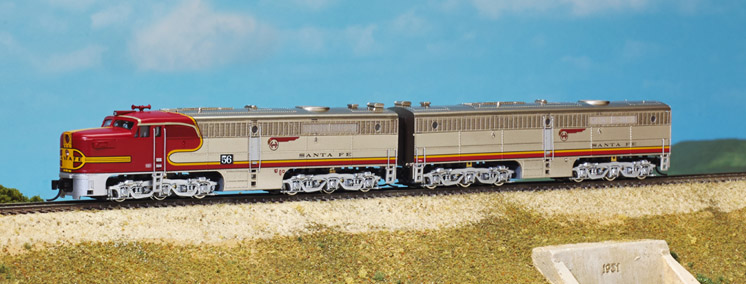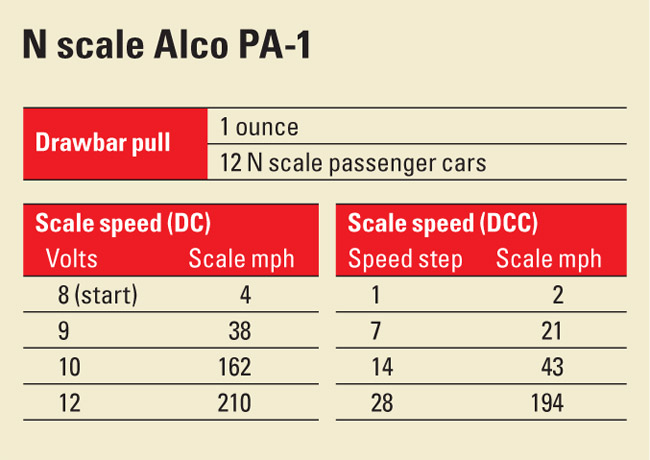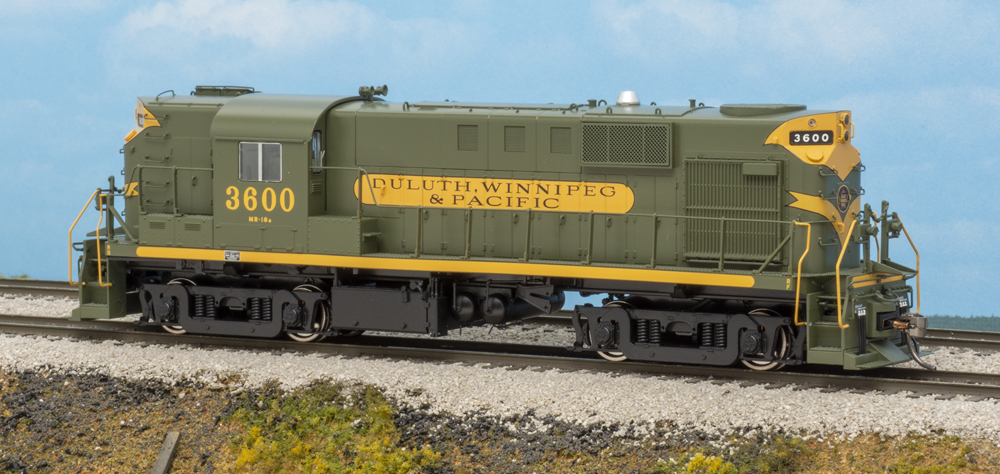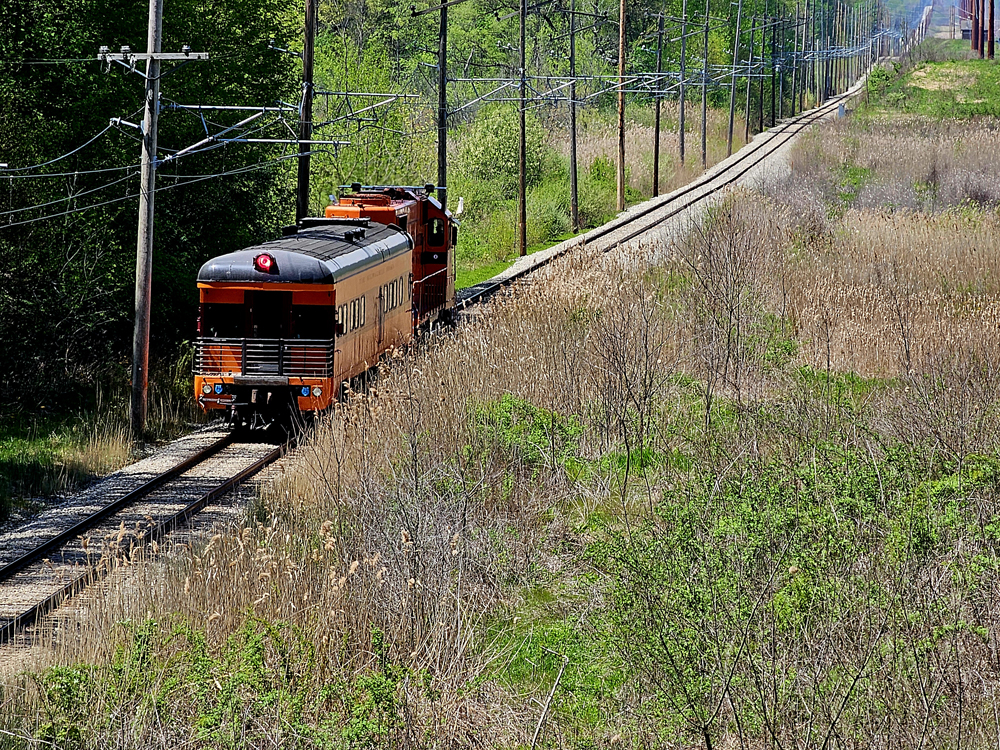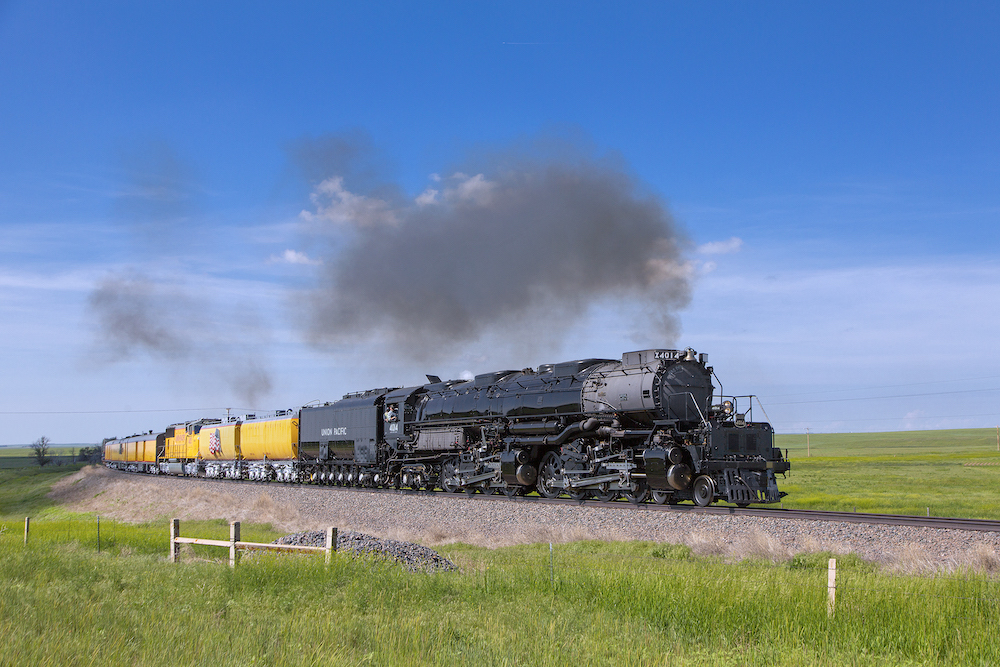History. The PA-1 and its cabless PB-1 booster were Alco’s post-World War II entry into the passenger locomotive market. Intended to challenge the dominance of Electro-Motive Division’s E series, Alco’s PA produced 2,000 horsepower from its single 16-cylinder 244 engine. In comparison, EMD’s E units used two 567-class engines to reach the same rating. But the 244 engine had been rushed into production, and proved unreliable. Alco sold 169 PAs – mostly to the Atchison, Topeka, & Santa Fe; Southern Pacific; and New York, New Haven & Hartford – and just 37 PB-1s.
Though the PA-1 was unpopular with railroads’ maintenance shops, the locomotive’s elegant design, by General Electric industrial designer Ray Stevenson, made it an icon on the rails and a favorite of railfans. A stretched-out version of Stevenson’s design for the four-axle Alco FA-1, the PA-1 shared that locomotive’s squared-off nose, raked windshield, and louvered headlight enclosure. But the PA had a longer nose, drop-equalized A-1-A trucks, horizontal-slit side grills, and a stylish “eyebrow” trim piece behind the cab doors. (The absence of both this “eyebrow” trim and the rear side portholes is the primary spotting difference between the PA-1 and its 2,250-hp successor, the PA-2.)
Some purchasers tried repowering the PA-1 with EMD or other engines, but that fix proved more trouble than it was worth. Many PA-1s served out their last days in freight service, thanks to their hefty General Electric Model 752 traction motors. Five PA-1s survive today, in various states of repair.
The body shell doesn’t skimp on the details. Grab irons are wire, and the radiator and side grills are finely etched metal. The horn and the steam generator stacks are separately applied parts, and there’s glazing in the portholes.
There’s also a molded plastic cab interior, without crew figures. On our model, the interior was mounted a little far forward, leaving the edge of the back wall visible through the windows.
The locomotive is equipped with Magne-Matic knuckle couplers, all mounted at the right height. The pilot coupler on the PA-1 is body-mounted; the other three on the A-B set are truck-mounted for better operation on tight curves. The N scale locomotive can handle 9-3⁄4″ curves.
Pivoting plastic diaphragms are mounted on the back of the A unit and both ends of the B. The diaphragms’ striker plates aren’t normally in contact, though they do touch when the units are pushed together (such as while backing). They didn’t interfere with negotiating the 10″ radius curves and no. 6 turnouts on our Salt Lake Route project railroad.
The RP-25 contour wheels on our sample were all in gauge. Though the PB-1 is unpowered, its trucks have electrical pickup wipers, in case the user wants to install a sound decoder and speaker under its shell.
All the major dimensions I checked matched photos and drawings in Model Railroader Cyclopedia, vol. 2: Diesel
Locomotives (Kalmbach Books, out of print), as did the placement of details.
As with most sound-decoder- equipped models, the locomotive took a lot of voltage to get going. The familiar rattle of the Alco 244 engine warm-up sequence started when the throttle reached 6V. The sounds remained steady, rather than skipping at low voltages, as some sound decoders do. As I increased the throttle, the motor sounds ramped up smoothly – well, as smoothly as an Alco prime mover ever did. The engine’s decoder is programmed with an effect that responds to throttle changes gradually, simulating the momentum of a loaded train. I also appreciated the automatic brake squeal that sounded when the throttle was quickly decreased.
The model started moving at 8V, rolling steadily at 4 scale mph. At 12V, it reached a top speed of 210 mph, almost twice the prototype’s top speed of 117 mph. The model surpassed that speed at about 9.5V. Since this would leave an only 1-1⁄2V range for prototypical speeds, I used our NCE Power Cab Digital Command Control system to program Configuration Variable 5 (Vhigh) to a value of 128. After this, the engine responded to 12V with a more prototypical top speed of 117 scale mph.
I was able to trigger additional sound capabilities using Broadway Limited’s DC Master, a control box that connects between a DC power pack and the track and allows access to several sound decoder functions. Using this device, I rang the bell, sounded the horn, and easily adjusted the sound effects volume.
I tested the locomotive under Digital Command Control before adjusting the value of CV5. The engine responded to speed step 1 with a slow, steady 2 mph roll, perfect for gently coupling onto a loaded passenger train. Just as it had under DC control, the locomotive topped out at an unprototypically fast 194 scale mph at speed step 28. Programming CV5 to 128 brought this down to a prototypical 119 scale mph.
In addition to the bell and horn sounds I already tested with the DC Master, a DCC throttle’s function keys can also trigger the sounds of a coupler crash, the dynamic brake fans, radiator fans, an air release, a grade-crossing horn sequence, and more. Modelers who like to operate with manual notching will appreciate the ability to use F5 and F6 to increase and decrease the sound of the engine rpm independent of the
locomotive speed.
Broadway Limited’s Paragon2 sound system offers precise control over practically every function of the locomotive. Each sound effect, from the prominent engine rpm, horn, and bell to the less frequent fans, coupler crash, wheel flange squeal, and fuel filler sound have their own individual volume settings. For those planning to advance consist the locomotive, perhaps paired in an A-A set or with a powered B unit, there’s a 28-step user-programmable speed table, as well as forward and reverse trim settings. The momentum is also adjustable.
Looking good. Our review sample is part of the first run of BLI N scale Alco PA locomotives. The company
announced a second run to be delivered later this year. Broadway Limited’s Paragon2 DCC-equipped model deserves a spot at the front of a crack passenger streamliner on any postwar N scale layout.
Manufacturer
Broadway Limited Imports
9A East Tower Circle
Ormond Beach, FL 32174
www.broadway-limited.com
Era: 1946 to 1960s
Road names (first run): PA-PB sets: Atchison, Topeka & Santa Fe (passenger warbonnet); Denver & Rio Grande Western; New York Central (lightning stripe); Pennsylvania RR (five-stripe Brunswick Green); Southern Pacific (“bloody nose”); and Union Pacific. PA unit only: ATSF (passenger warbonnet or “gold bonnet”); Erie Lackawanna (maroon and gray); Lehigh Valley (red and black); New York, New Haven & Hartford (McGinnis scheme); and Nickel Plate Road (“bluebird” scheme). Separately sold PA and PB units: NYC, PRR, SP, UP, and undecorated.
Features
- All-wheel drive with traction tires on rear axle
- Cab interior
- Etched-metal grills
- Five-pole skew-wound motor with dual brass flywheels
- Light-emitting-diode Mars light and headlight (A unit only)
- Magne-Matic couplers
- Minimum radius: 93⁄4″
- Paragon2 Digital Command Control sound decoder
- Pivoting diaphragms
- Roadname-specific details
- Simulated stainless steel plated finish (ATSF only)
- Weight: 3.6 ounces (A unit), 2.5 ounces (unpowered B unit)
- Wire grab irons





